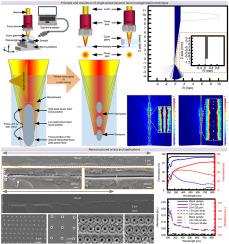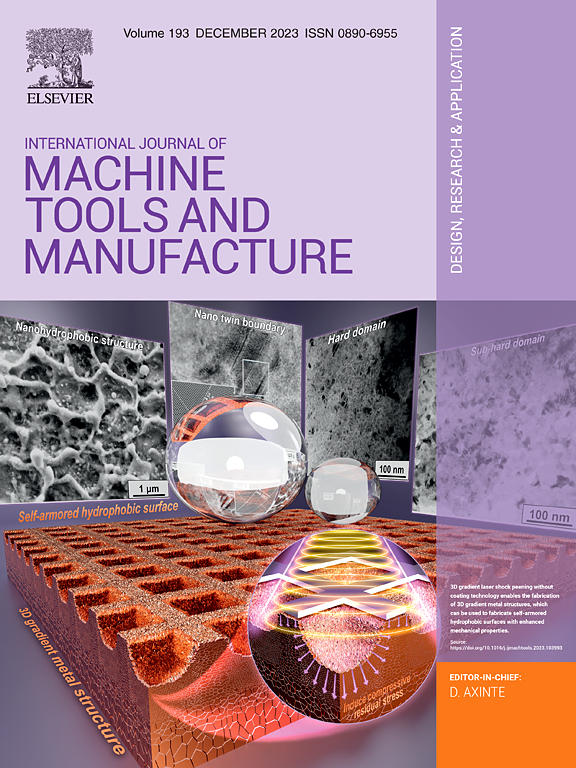超快激光等离子体动力学实现了透明材料中的超细垂直纳米通道阵列
IF 18.8
1区 工程技术
Q1 ENGINEERING, MANUFACTURING
International Journal of Machine Tools & Manufacture
Pub Date : 2025-08-16
DOI:10.1016/j.ijmachtools.2025.104322
引用次数: 0
摘要
在透明材料中直接制造具有超高纵横比(1000:1)的垂直纳米通道一直受到传统超快激光加工固有的衍射限制焦点和等离子体诱导不稳定性的阻碍。为了解决这些挑战,我们引入了一种动态聚焦均匀光场技术,该技术集成了高折射率光学介质,将激光焦斑压缩到衍射极限(~ 700 nm)以下,同时利用非线性克尔效应延长轴向能量分布。这种方法在时空上动态地重新分配能量,将等离子体爆炸压力降低86% (1440 nm对192 nm),并实现对纳米通道几何形状的确定性控制。通过双温度方程模拟和时间分辨等离子体光谱,我们建立了一个预测框架,将加工参数(如覆盖玻璃厚度、脉冲宽度和能量)与纳米结构尺寸联系起来,实现了接近1000:1的宽高比,例如长度为182 μm、宽度为192 nm的纳米通道。该技术的关键创新包括非线性焦点漂移工程,它将横向分辨率与纵向能量沉积解耦,以及基于数值模拟和光谱的等离子体抑制机制,通过多维光场控制确保结构完整性。此外,我们展示了第一次在熔融二氧化硅中单步制备三维体积衍射光栅,通道间距低于1.25 μm,光学响应定制,如35.9%的漫射透过率和0.52的吸收系数在247 nm。这种方法超越了传统的权衡,提供精度、可扩展性和多功能性:它实现了100纳米以下的特征控制,实现了通孔和多深度结构等复杂架构的可扩展制造,并为集成光子学、纳米流体学和量子光学中的超材料量身定制光学特性。通过解决等离子体驱动的不稳定性和热积累,我们的技术解锁了低损耗波导,单分子传感器和拓扑光子晶体的变革性应用。这项工作将激光纳米制造重新定义为脆性材料中高精度、可扩展3D结构的通用平台,将其定位为下一代光学和量子技术的基石。本文章由计算机程序翻译,如有差异,请以英文原文为准。

Ultrafast laser plasma dynamics enabled ultrafine vertical nanochannel array in transparent materials
The direct fabrication of vertical nanochannels with ultrahigh aspect ratios (1000:1) in transparent materials has long been hindered by diffraction-limited focal spots and plasma-induced instabilities inherent to conventional ultrafast laser processing. To address these challenges, we introduce a dynamic focusing homogenized light field technique, which integrates a high-refractive-index optical medium to compress the laser focal spot below the diffraction limit (∼700 nm) while leveraging nonlinear Kerr effects to elongate the axial energy distribution. This approach dynamically redistributes energy spatiotemporally, suppressing plasma explosion pressures by 86 % (1440 nm vs. 192 nm) and enabling deterministic control over nanochannel geometry. Through dual-temperature equation simulations and time-resolved plasma spectroscopy, we establish a predictive framework linking processing parameters—such as cover glass thickness, pulse width, and energy—to nanostructure dimensions, achieving aspect ratio close to 1000:1, exemplified by nanochannels measuring 182 μm in length and 192 nm in width. Key innovations of this technique include nonlinear focal drift engineering, which decouples transverse resolution from longitudinal energy deposition, and a plasma suppression mechanism informed by numerical simulations and spectroscopy, ensuring structural integrity through multi-dimensional light field control. Furthermore, we demonstrate the first single-step fabrication of 3D volumetric diffraction gratings in fused silica with sub-1.25 μm channel spacing and tailored optical responses, such as 35.9 % diffuse transmittance and a 0.52 absorption coefficient at 247 nm. This method transcends traditional trade-offs, offering precision, scalability, and versatility: it achieves sub-100 nm feature control, enables scalable fabrication of complex architectures like through-hole and multi-depth structures, and tailors optical properties for metamaterials in integrated photonics, nanofluidics, and quantum optics. By resolving plasma-driven instability and thermal accumulation, our technique unlocks transformative applications in low-loss waveguides, single-molecule sensors, and topological photonic crystals. This work redefines laser nanofabrication as a universal platform for high-precision, scalable 3D structuring in brittle materials, positioning it as a cornerstone for next-generation optical and quantum technologies.
求助全文
通过发布文献求助,成功后即可免费获取论文全文。
去求助
来源期刊
CiteScore
25.70
自引率
10.00%
发文量
66
审稿时长
18 days
期刊介绍:
The International Journal of Machine Tools and Manufacture is dedicated to advancing scientific comprehension of the fundamental mechanics involved in processes and machines utilized in the manufacturing of engineering components. While the primary focus is on metals, the journal also explores applications in composites, ceramics, and other structural or functional materials. The coverage includes a diverse range of topics:
- Essential mechanics of processes involving material removal, accretion, and deformation, encompassing solid, semi-solid, or particulate forms.
- Significant scientific advancements in existing or new processes and machines.
- In-depth characterization of workpiece materials (structure/surfaces) through advanced techniques (e.g., SEM, EDS, TEM, EBSD, AES, Raman spectroscopy) to unveil new phenomenological aspects governing manufacturing processes.
- Tool design, utilization, and comprehensive studies of failure mechanisms.
- Innovative concepts of machine tools, fixtures, and tool holders supported by modeling and demonstrations relevant to manufacturing processes within the journal's scope.
- Novel scientific contributions exploring interactions between the machine tool, control system, software design, and processes.
- Studies elucidating specific mechanisms governing niche processes (e.g., ultra-high precision, nano/atomic level manufacturing with either mechanical or non-mechanical "tools").
- Innovative approaches, underpinned by thorough scientific analysis, addressing emerging or breakthrough processes (e.g., bio-inspired manufacturing) and/or applications (e.g., ultra-high precision optics).

 求助内容:
求助内容: 应助结果提醒方式:
应助结果提醒方式:


